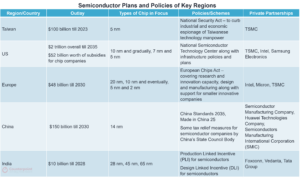The past two years have brought out the importance of semiconductors in driving economies like never before. Whether it is the demand shock created by COVID-19 or the US-China tech war, the need to diversify the semiconductor supply chain has dawned on governments the world over. The issue is also being eagerly discussed at global forums, the recent meeting of the Quadrilateral Security Dialogue (or Quad) being the latest example. Quad members US, India, Japan and Australia have decided to work together to secure the semiconductor supply chain.
Another factor pushing such efforts is China’s attempts to set global standards for emerging technologies like 5G internet, IoT and AI through its “China Standards 2035” plan, which seeks to build on the “Made in China 2025” plan. Clearly, the ongoing global chips shortage has only accentuated the concerns about over-dependence on a few markets for critical technologies.
Many economies are currently at work to achieve self-dependence in meeting their chip requirements. But it takes years to build semiconductor fabrication facilities and much expenditure to maintain and upgrade them. Therefore, the idea of becoming “self-sufficient” or “independent” is not a viable option. Still, many economies like the US, EU and East Asian countries are calibrating their measures to indigenize as well as diversify the semiconductor supply chain to have a more resilient supply network. We list below a few such efforts:
Taiwan
As the world’s largest contract chip manufacturer, TSMC has hugely benefited from the global chip shortage. To maintain this leadership and diversify its production locations, it plans $45 billion worth of capital investment in Taiwan and beyond.
US
A $52-billion plan includes incentivizing the production of “mature node” semiconductors used by the automobile, medical device, agricultural machinery and defense equipment industries. The legislation to this effect, which is broadly supported by the chip industry, would also facilitate funding for new chip fab units. This would help the companies that build them and fabless companies such as AMD, Nvidia and Qualcomm, which rely on contractors to manufacture their products. US’ share in chip manufacturing has dropped to around 11% from almost 40% in the last 30 years. With this move, the US can potentially restore its position in the global supply chain.
Europe
With the onset of the European CHIPS Act, Europe aims to double its current market share of semiconductor production to 20% by 2030 with an allocation of $49 billion. The plan includes building a new framework to ensure the security of supply along with a dedicated ‘Chips Fund’ to focus on exports. The said plan will also have a provision to ‘halt exports’ as a last resort in case of emergencies and crises. The EU is also mobilizing more than €43 billion in public and private funding to support broader policy goals around digitalization, green transition and R&D.
China
Under the “Made in China 2025” plan, China aims to produce 70% of the semiconductors it uses by 2025. The government has also signed massive deals with SMIC in this regard. The said project will also have a minority holding of the government along with funding support from the respective local government. Most recently, the country also introduced many industrial policy measures to help boost its domestic semiconductor industry through tax relief to chip manufacturers. For example, a manufacturer that has been in operation for more than 15 years and makes 28 nm or more advanced chips will be exempted from corporate income tax for up to 10 years.
India
The most recent participant in the chip world, India has established its presence by introducing a semiconductor policy under the Production Linked Incentive scheme. With an outlay of almost $10 billion for six years, the scheme aims to incentivize all major stages of semiconductor production – Semi/Display Fabs, Semi ATMP units and Designing. This scheme is by far the most comprehensive package designed for the sector by the government. With a special provision on designing, the Indian government has worked well to leverage this advantage of the country compared to the rest of the world. One of the best parts has been the promise of nurturing (under DLI) some 100 domestic semiconductor design companies, offering hope to the many design-linked concerns of the ecosystem.

Geopolitics
The geopolitical dynamics will also shape the future of the semiconductor market, an angle that has come under much scrutiny during the last couple of years. Various ‘alliances’ and ‘councils’ are already at work preparing plans to diversify the supply chain and gain “self-sufficiency”. On the one hand, we have the Quad alliance taking shape in the Indo-Pacific region, while on the other hand, we have the newly formed EU-US tech alliance called the Trade and Technology Council, where France is expected to pivot the semiconductor negotiations. Moreover, the European Alliance for Processors and Semiconductors is bringing many EU member states together for business, research and technology under the semiconductor ambit.
A key differentiator among all these efforts would be how well each economy utilizes the combination of money, time, innovation and know-how, using both international and homegrown talent. Besides, they will have to position themselves in a way that minimizes risks and reshoring impact when it comes to trade inflows and outflows. This is especially true with respect to the US, EU and Southeast Asia considering other changing factors like labor cost, economic tensions (Ukraine-Russia war) and even the not-so-gone COVID-19, which have the ability to impact the demand-supply harmony of this ecosystem.
*Source for the table: Government documents and notifications

